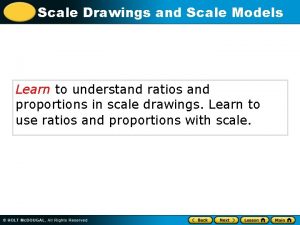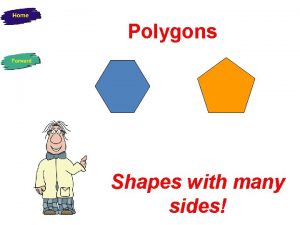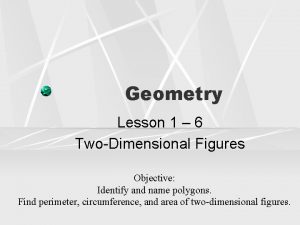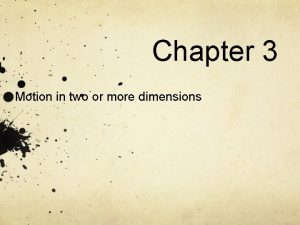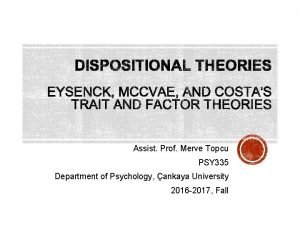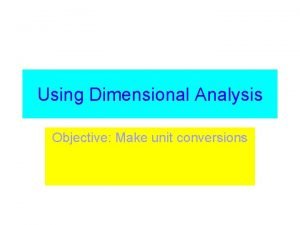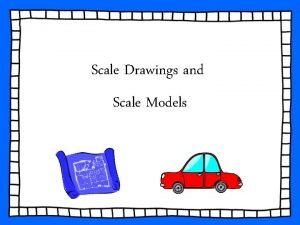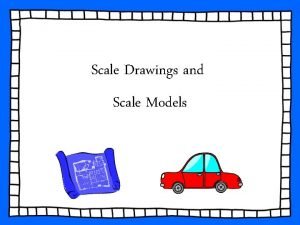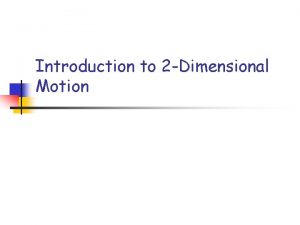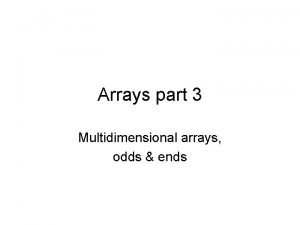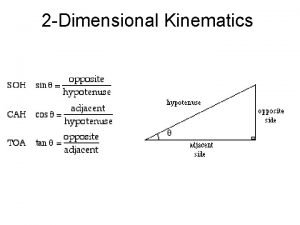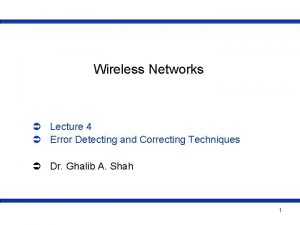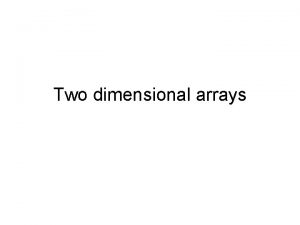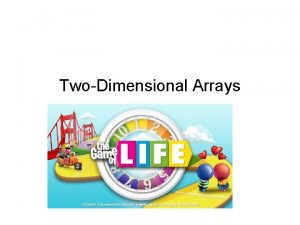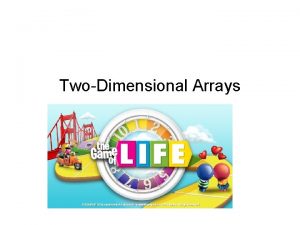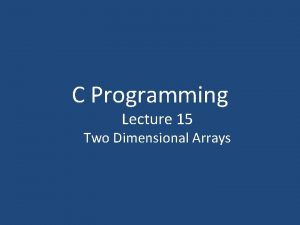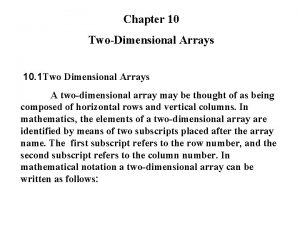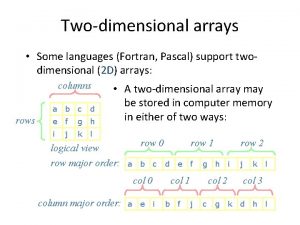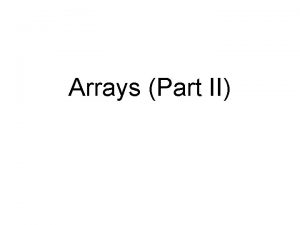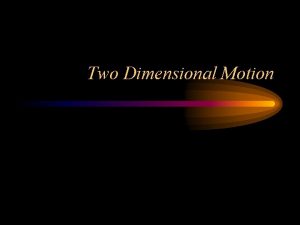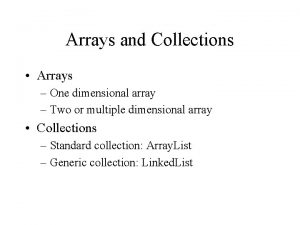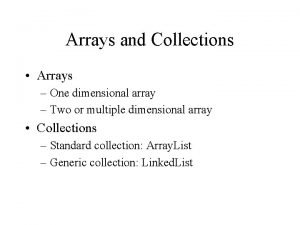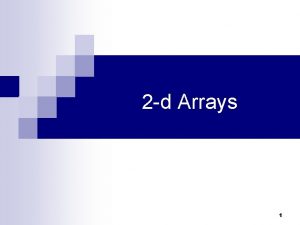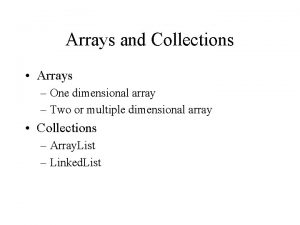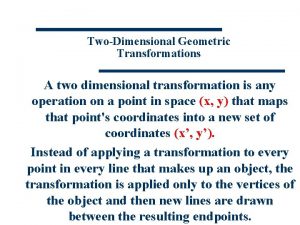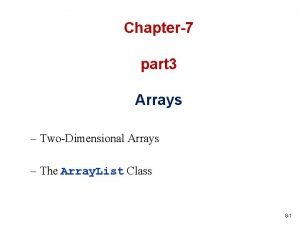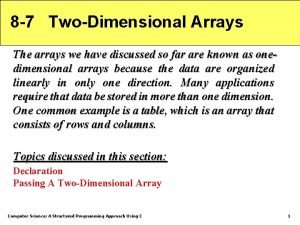Two Dimensional Arrays Twodimensional Arrays 0 1 2



![Example: Matrix Addition #define ROWS 3 #define COLS 4 int main() { int a[ROWS][COLS] Example: Matrix Addition #define ROWS 3 #define COLS 4 int main() { int a[ROWS][COLS]](https://slidetodoc.com/presentation_image/b87d9bf76ed2ff140c768d3ca2350abf/image-4.jpg)






![int solve(int maze[][WIDTH], int h, int w, int step) { // check borders if int solve(int maze[][WIDTH], int h, int w, int step) { // check borders if](https://slidetodoc.com/presentation_image/b87d9bf76ed2ff140c768d3ca2350abf/image-11.jpg)
![SOLVE A MAZE – Main int main() { int maze[HEIGHT][WIDTH] = {EMPTY}; init_maze(maze); print_maze(maze); SOLVE A MAZE – Main int main() { int maze[HEIGHT][WIDTH] = {EMPTY}; init_maze(maze); print_maze(maze);](https://slidetodoc.com/presentation_image/b87d9bf76ed2ff140c768d3ca2350abf/image-12.jpg)





![Eight Queens Puzzle – Take 1 int solve(int board[][SIZE]) { int row, col; } Eight Queens Puzzle – Take 1 int solve(int board[][SIZE]) { int row, col; }](https://slidetodoc.com/presentation_image/b87d9bf76ed2ff140c768d3ca2350abf/image-18.jpg)

![Eight Queens Puzzle – Take 1 int check(int board[][SIZE], int row, int col) { Eight Queens Puzzle – Take 1 int check(int board[][SIZE], int row, int col) {](https://slidetodoc.com/presentation_image/b87d9bf76ed2ff140c768d3ca2350abf/image-20.jpg)


![Eight Queens Puzzle – Solution int solve(int board[][SIZE], int row) { int col; if Eight Queens Puzzle – Solution int solve(int board[][SIZE], int row) { int col; if](https://slidetodoc.com/presentation_image/b87d9bf76ed2ff140c768d3ca2350abf/image-23.jpg)
![Solution #include <stdio. h> #define SIZE 4 int main() { int A[SIZE ] = Solution #include <stdio. h> #define SIZE 4 int main() { int A[SIZE ] =](https://slidetodoc.com/presentation_image/b87d9bf76ed2ff140c768d3ca2350abf/image-24.jpg)
- Slides: 24

Two Dimensional Arrays

Two-dimensional Arrays 0 1 2 3 4 5 6 7 8 9 10 0 1 2 3 4 x 11 n Declaration: columns int matrix[4][11]; rows

Element Access n Access the j-th element (column) of the th array (row) column matrix[i][j] row i-
![Example Matrix Addition define ROWS 3 define COLS 4 int main int aROWSCOLS Example: Matrix Addition #define ROWS 3 #define COLS 4 int main() { int a[ROWS][COLS]](https://slidetodoc.com/presentation_image/b87d9bf76ed2ff140c768d3ca2350abf/image-4.jpg)
Example: Matrix Addition #define ROWS 3 #define COLS 4 int main() { int a[ROWS][COLS] = {{1, 2, 3, 4}, {5, 6, 7, 8}, {9, 10, 11, 12}}; int b[ROWS][COLS] = {{1, 1, 1, 1}, {2, 2, 2, 2}, {3, 3, 3, 3}}; int c[ROWS][COLS]; int i = 0, j = 0; for (i = 0; i < ROWS; ++i) for (j = 0; j < COLS; ++j) c[i][j] = a[i][j] + b[i][j]; /* print c */. . . return 0; }

Exercise n Calculate a matrix transpose: ¨ define two int matrices A and B of size 5 x 5 ¨ initialize A with any values you want. ¨ compute AT, the matrix transpose of A, in to B: B[i][j] = A[j][i] ¨ Print B.

SOLVE A MAZE Our maze is represented by a rectangle divided into small squares = a matrix n It has: n ¨ Starting point ¨ End point ¨ Walls ¨ Empty cells that we can travel through

SOLVE A MAZE How do we solve a maze? n We need to find a path from our current location to the end point. Recursion: - Find a path from a neighbor cell to the end point Add the current cell in the beginning of the path.

SOLVE A MAZE What happens if no path from any of our neighbors exists? Return to the cell we arrived from. Stopping criteria: ¨ Reach the End Point DONE ¨ Hit a wall or an already visited cell Reverse

SOLVE A MAZE Algorithm: § When you reach a cell: Try walking down / right / up / left in some order until: § Success = Reach END § Failure = Checked all possible paths §

SOLVE A MAZE Reverse when you hit: § A Wall § A border § An already visited cell (not necessarily in the path) The function solve receives: - maze (2 d matrix) - (row, col) of current cell - step (cell num on the path)
![int solveint mazeWIDTH int h int w int step check borders if int solve(int maze[][WIDTH], int h, int w, int step) { // check borders if](https://slidetodoc.com/presentation_image/b87d9bf76ed2ff140c768d3ca2350abf/image-11.jpg)
int solve(int maze[][WIDTH], int h, int w, int step) { // check borders if ( (h < 0) || (h >= HEIGHT) || (w < 0) || (w >= WIDTH) ) return FALSE; switch (maze[h][w]) { case END: return TRUE; case EMPTY: maze[h][w] = step; // the actual walk along the path if (solve(maze, h + 1, w, step + 1) || solve(maze, h, w + 1, step + 1) || solve(maze, h - 1, w, step + 1) || solve(maze, h, w - 1, step + 1)) return TRUE; maze[h][w] = VISITED; // Failed default: // PATH or VISITED or failed EMPTY return FALSE; } }
![SOLVE A MAZE Main int main int mazeHEIGHTWIDTH EMPTY initmazemaze printmazemaze SOLVE A MAZE – Main int main() { int maze[HEIGHT][WIDTH] = {EMPTY}; init_maze(maze); print_maze(maze);](https://slidetodoc.com/presentation_image/b87d9bf76ed2ff140c768d3ca2350abf/image-12.jpg)
SOLVE A MAZE – Main int main() { int maze[HEIGHT][WIDTH] = {EMPTY}; init_maze(maze); print_maze(maze); if (solve(maze, 0, 0, 1)) { printf("Solution: n"); print_maze(maze); } else printf("No solutionn"); return 0; }

Eight Queens Puzzle Place eight chess queens on an 8× 8 chessboard so that no two queens attack each other. A solution requires that no two queens share the same row, column, or diagonal.

Eight Queens Puzzle

Eight Queens Puzzle Can you estimate how many distinct solutions exist? There are 92 distinct solutions. When uniting solutions that differ only by symmetry (rotations and reflections) – 12 solutions.

Eight Queens Puzzle Searching for a solution - insights: n There is exactly one queen in each row. Thus, in each step place a queen in the next row that does not contain a queen. n In the next row - consider only the columns that are not already attacked by another queen.

Eight Queens Puzzle – Take 1 #define SIZE 8 #define EMPTY 0 #define QUEEN 1 int main() { int board[SIZE] = {EMPTY}; if (solve(board)) print_board(board); else printf("Failed to solve the %d queens problemn"); return 0; }
![Eight Queens Puzzle Take 1 int solveint boardSIZE int row col Eight Queens Puzzle – Take 1 int solve(int board[][SIZE]) { int row, col; }](https://slidetodoc.com/presentation_image/b87d9bf76ed2ff140c768d3ca2350abf/image-18.jpg)
Eight Queens Puzzle – Take 1 int solve(int board[][SIZE]) { int row, col; } for (row = 0; row < SIZE; ++row) { for (col = 0; col < SIZE; ++col) { if (check(board, row, col)) board[row][col] = QUEEN; } if (col == SIZE) return FALSE; } return TRUE;

Eight Queens Puzzle – Take 1 // helper - returns FALSE if a QUEEN is found on a path // Prevents code duplication in check int helper(int board[][SIZE], int row, int col, int add_row, int add_col) { int i, j; i = row + add_row; j = col + add_col; while ((i >= 0) && (i < SIZE) && (j >= 0) && (j < SIZE)) { if (board[i][j] == QUEEN) return FALSE; i += add_row; j += add_col; } return TRUE; }
![Eight Queens Puzzle Take 1 int checkint boardSIZE int row int col Eight Queens Puzzle – Take 1 int check(int board[][SIZE], int row, int col) {](https://slidetodoc.com/presentation_image/b87d9bf76ed2ff140c768d3ca2350abf/image-20.jpg)
Eight Queens Puzzle – Take 1 int check(int board[][SIZE], int row, int col) { return // check column (helper(board, row, col, 1, 0) && helper(board, row, col, -1, 0) && // check row helper(board, row, col, 0, 1) && helper(board, row, col, 0, -1) && // check diagonal helper(board, row, col, 1, 1) && helper(board, row, col, 1, -1) && // check other diagonal helper(board, row, col, -1, 1) &&helper(board, row, col, -1)); }

Eight Queens Puzzle – Problem After adding 5 queens we get:

Eight Queens Puzzle – Solution Add Recursion! When there is no solution, return to the last added Queen and move her to the next possible cell. If no such cell exists – move one Queen up. n Change solve to be recursive. Now solve receives the board and the row number.
![Eight Queens Puzzle Solution int solveint boardSIZE int row int col if Eight Queens Puzzle – Solution int solve(int board[][SIZE], int row) { int col; if](https://slidetodoc.com/presentation_image/b87d9bf76ed2ff140c768d3ca2350abf/image-23.jpg)
Eight Queens Puzzle – Solution int solve(int board[][SIZE], int row) { int col; if (row == SIZE) return TRUE; for (col = 0; col < SIZE; ++col) if (check(board, row, col)) { board[row][col] = QUEEN; if (solve(board, row + 1)) return TRUE; // else - reset last assignment, try next possible column board[row][col] = EMPTY; } return FALSE; }
![Solution include stdio h define SIZE 4 int main int ASIZE Solution #include <stdio. h> #define SIZE 4 int main() { int A[SIZE ] =](https://slidetodoc.com/presentation_image/b87d9bf76ed2ff140c768d3ca2350abf/image-24.jpg)
Solution #include <stdio. h> #define SIZE 4 int main() { int A[SIZE ] = { {1, 2, 3, 4}, {5, 6, 7, 8}, {9, 10, 11, 12}, {13, 14, 15, 16}}; int i, j, B[SIZE ]; // Compute the transpose for (i = 0; i < SIZE ; ++i) for (j = 0; j < SIZE ; ++j) B[i][j] = A[j][i]; // Print B for (i = 0; i < SIZE ; ++i) { for (j = 0; j < SIZE ; ++j) printf("%3 d ", B[i][j]); printf("n"); } return 0; }
 Circular motion is one dimensional or two dimensional
Circular motion is one dimensional or two dimensional Two dimensional motion and vectors
Two dimensional motion and vectors What are two and three dimensional shapes
What are two and three dimensional shapes A topographic map is a two dimensional model
A topographic map is a two dimensional model A topographic map is a two dimensional model
A topographic map is a two dimensional model A 2-dimensional area with a known boundary is called as
A 2-dimensional area with a known boundary is called as A proportional two dimensional drawing of an object
A proportional two dimensional drawing of an object What shape has 5 sides
What shape has 5 sides A topographic map is a two dimensional model
A topographic map is a two dimensional model 1 6 practice two dimensional figures
1 6 practice two dimensional figures Two dimensional motion
Two dimensional motion Eysenck’s two-dimensional scheme
Eysenck’s two-dimensional scheme Contoh array 1 dimensi
Contoh array 1 dimensi What are two dimensional analysis of objectives
What are two dimensional analysis of objectives Two dimensions of media
Two dimensions of media A proportional two dimensional drawing of an object
A proportional two dimensional drawing of an object A proportional two-dimensional drawing of an object
A proportional two-dimensional drawing of an object Gradient topographic map
Gradient topographic map Two dimensional motion definition
Two dimensional motion definition Engineering mechanics chapter 2 solutions
Engineering mechanics chapter 2 solutions Elements of art accordion book
Elements of art accordion book Pizza would be considered a 2-dimensional visual aid
Pizza would be considered a 2-dimensional visual aid Haskell two dimensional array
Haskell two dimensional array Salmon often jump waterfalls to reach
Salmon often jump waterfalls to reach Wifi error correction
Wifi error correction






